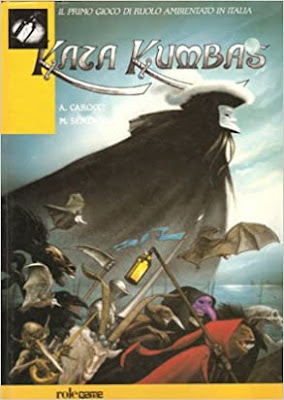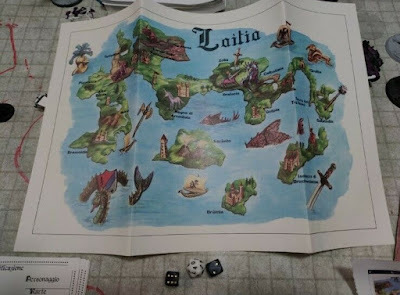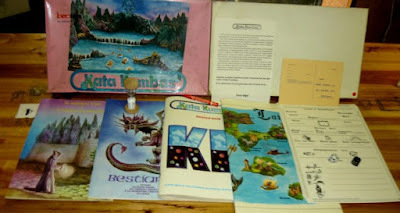Kata Kumbas
 Second edition cover by John HoweBecause I know so little about the early roleplaying game scenes outside the English-speaking world, I appreciate it when readers educate me. Recently, Adamo Degradi shared some information about the 1980 French game, Le Château des Sortilèges, about which I previously knew nothing. I thanked him for this and he then asked me if I'd like to know something about an early Italian RPG, Kata Kumbas. Naturally, I was quite interested, since I'd never heard of the game before, let alone seen it.
Second edition cover by John HoweBecause I know so little about the early roleplaying game scenes outside the English-speaking world, I appreciate it when readers educate me. Recently, Adamo Degradi shared some information about the 1980 French game, Le Château des Sortilèges, about which I previously knew nothing. I thanked him for this and he then asked me if I'd like to know something about an early Italian RPG, Kata Kumbas. Naturally, I was quite interested, since I'd never heard of the game before, let alone seen it. Designed by Agostino Carrocci and Massimo Senzacqua, Kata Kumbas was the second Italian language roleplaying game ever published. It first appeared in 1984 just a few months after I Signori del Caos. Unlike its predecessor, Kata Kumbas featured an original rules system – I Signori del Caos was derivative of AD&D – and, more importantly, a setting based on a fantastical version of Italy (or Laitia). Laitia has many inspirations, from Orlando Furioso to Italo Calvino's Italian Folktales to sword-and-sandal movies. As a result, Kata Kumbas has a comedic and picaresque tone, especially when compared to most English-language games available at the time.
 Map of LaitiaThere are several genuinely unique aspects of the game's design, a couple of which I want to highlight. First, the characters are the players themselves, whose minds have been transplanted to another reality. Once there, the players must choose a new persona from among four different kin (Hyperboreans, Roma, the Ancient People, and the New People) and thirteen classes (or castes). Speaking only for myself, I find this premise fascinating, not least because it strongly echoes many early fantasy stories, in which the protagonist is a stranger to the world, having come to it from present-day Earth. I'm hard pressed to think of any English-language RPGs where this is the case, so it's all the more remarkable that Kata Kumbas embraces it.
Map of LaitiaThere are several genuinely unique aspects of the game's design, a couple of which I want to highlight. First, the characters are the players themselves, whose minds have been transplanted to another reality. Once there, the players must choose a new persona from among four different kin (Hyperboreans, Roma, the Ancient People, and the New People) and thirteen classes (or castes). Speaking only for myself, I find this premise fascinating, not least because it strongly echoes many early fantasy stories, in which the protagonist is a stranger to the world, having come to it from present-day Earth. I'm hard pressed to think of any English-language RPGs where this is the case, so it's all the more remarkable that Kata Kumbas embraces it.
 Contents of the first edition boxed setThe second unique aspect to the game I want to draw attention to is the inclusion of a five-minute hourglass, in addition to dice. The hourglass was apparently used to keep track of how long a spirit remained bound to a summoner. Once again, this is something I can't recall ever seeing incorporated into an English-language RPG.
Contents of the first edition boxed setThe second unique aspect to the game I want to draw attention to is the inclusion of a five-minute hourglass, in addition to dice. The hourglass was apparently used to keep track of how long a spirit remained bound to a summoner. Once again, this is something I can't recall ever seeing incorporated into an English-language RPG. There is, I am sure, a great deal more that could be said about Kata Kumbas, but I will leave that to readers who have actually seen and played the game themselves. Based solely on the little I've gleaned about it, I think it's something I'd probably have enjoyed. It's also a reminder of how delightfully different the RPG scenes of other countries can be from those with which I am already familiar.
Published on January 31, 2022 09:00
No comments have been added yet.
James Maliszewski's Blog
- James Maliszewski's profile
- 3 followers
James Maliszewski isn't a Goodreads Author
(yet),
but they
do have a blog,
so here are some recent posts imported from
their feed.



